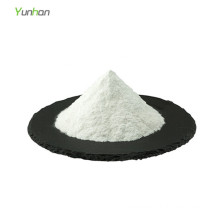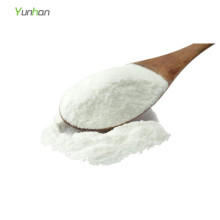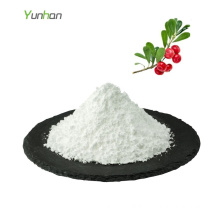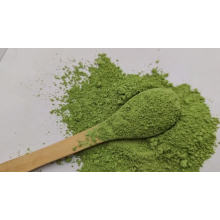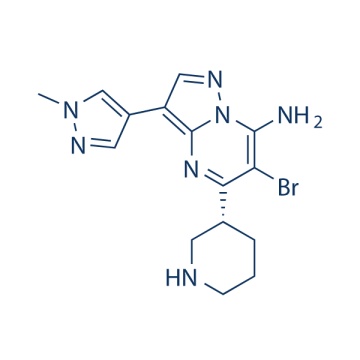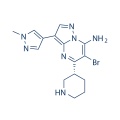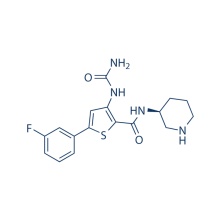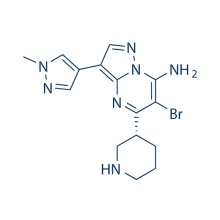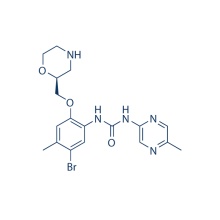MK-8776 (SCH 900776) 891494-63-6
Product Description
.cp_wz table {border-top: 1px solid #ccc;border-left:1px solid #ccc; } .cp_wz table td{border-right: 1px solid #ccc; border-bottom: 1px solid #ccc; padding: 5px 0px 0px 5px;} .cp_wz table th {border-right: 1px solid #ccc;border-bottom: 1px solid #ccc; padding: 5px 0px 0px 5px;}
Molecular Weight:
376.25 SCH 900776 is a selective Chk1 inhibitor with IC50 of 3 nM. It shows 500-fold selectivity against Chk2. Phase 2.
Biological Activity
SCH 900776 is a less Potent Inhibitor of Chk2 and CDK2 with IC50 of 1.5
μM and 0.16 μM, respectively. SCH 900776 shows no significant inhibition
of cytochrome P450 human liver microsomal isoforms 1A2, 2C9, 2C19, 2D6,
and 3A4. SCH 900776 induces a dose-dependent loss of DNA replication
capability 24 hours after hydroxyurea exposure. SCH 900776 enhances the
γ-H2AX response of hydroxyurea, 5-fluoruracil, and cytarabine. In
combination with an antimetabolite, SCH 900776 induces accumulation of
γ-H2AX within 2 hours, indicative of replication fork collapse and
double stranded DNA breaks.
Additionally, SCH 900776 suppresses
accumulation of the Chk1 pS296 autophosphorylation in a dose-dependent
manner. Exposure of proliferating WS1 cells to SCH 900776 is associated
with rapid, dose-dependent accumulation of Chk1 pS345, indicating that
cycling populations of normal cells induce Chk1 pS345 following exposure
to SCH 900776 as part of a futile cycle, perhaps driven by AT-family
kinases and DNA-PK.
Administered 30 minutes after gemcitabine, 4 mg/kg SCH 900776 is
sufficient to induce the γ-H2AX biomarker while 8 mg/kg leads to
enhanced tumor pharmacodynamic and regression responses relative to
gemcitabine or SCH 900776 alone. Dose escalation of SCH 900776 (16 mg/kg
and 32 mg/kg) induces incremental improvements in tumor response.
Importantly, doses of SCH 900776 associate with robust biomarker
activation and improved tumor response are not associated with enhanced
toxicity of gemcitabine on hematological parameters in BALB/c mice.
Protocol(Only for Reference)
Kinase Assay: [1]
Animal Study: [1]
Conversion of different model animals based on BSA (Value based on data from FDA Draft Guidelines)
For example, to modify the dose of resveratrol used for a mouse (22.4 mg/kg) to a dose based on the BSA for a rat, multiply 22.4 mg/kg by the Km factor for a mouse and then divide by the Km factor for a rat. This calculation results in a rat equivalent dose for resveratrol of 11.2 mg/kg.
Chemical Information
Molarity Calculator
Dilution Calculator
Molecular Weight Calculator
Contact us if you need more details on 891494-63-6. We are ready to answer your questions on packaging, logistics, certification or any other aspects about MK-8776 891494-63-6、SCH 900776 891494-63-6. If these products fail to match your need, please contact us and we would like to provide relevant information.
Molecular Weight:
376.25 SCH 900776 is a selective Chk1 inhibitor with IC50 of 3 nM. It shows 500-fold selectivity against Chk2. Phase 2.
Biological Activity
SCH 900776 is a less Potent Inhibitor of Chk2 and CDK2 with IC50 of 1.5
μM and 0.16 μM, respectively. SCH 900776 shows no significant inhibition
of cytochrome P450 human liver microsomal isoforms 1A2, 2C9, 2C19, 2D6,
and 3A4. SCH 900776 induces a dose-dependent loss of DNA replication
capability 24 hours after hydroxyurea exposure. SCH 900776 enhances the
γ-H2AX response of hydroxyurea, 5-fluoruracil, and cytarabine. In
combination with an antimetabolite, SCH 900776 induces accumulation of
γ-H2AX within 2 hours, indicative of replication fork collapse and
double stranded DNA breaks.
Additionally, SCH 900776 suppresses
accumulation of the Chk1 pS296 autophosphorylation in a dose-dependent
manner. Exposure of proliferating WS1 cells to SCH 900776 is associated
with rapid, dose-dependent accumulation of Chk1 pS345, indicating that
cycling populations of normal cells induce Chk1 pS345 following exposure
to SCH 900776 as part of a futile cycle, perhaps driven by AT-family
kinases and DNA-PK.
Administered 30 minutes after gemcitabine, 4 mg/kg SCH 900776 is
sufficient to induce the γ-H2AX biomarker while 8 mg/kg leads to
enhanced tumor pharmacodynamic and regression responses relative to
gemcitabine or SCH 900776 alone. Dose escalation of SCH 900776 (16 mg/kg
and 32 mg/kg) induces incremental improvements in tumor response.
Importantly, doses of SCH 900776 associate with robust biomarker
activation and improved tumor response are not associated with enhanced
toxicity of gemcitabine on hematological parameters in BALB/c mice.
Protocol(Only for Reference)
Kinase Assay: [1]
| Chk1 SPA assay | An in vitro assay utilizing recombinant His-Chk1 expressed in the baculovirus expression system as an enzyme source and biotinylated peptide based upon CDC25C as substrate. His-Chk1 is diluted to 32 nM in kinase buffer containing 50 mM Tris pH 8.0, 10 mM MgCl2, and 1 mM DTT. CDC25C (CDC25 Ser216 C-term biotinylated peptide) peptide is diluted to 1.93 μM in kinase buffer. For each kinase reaction, 20 μL of 32 nM Chk1 enzyme solution and 20 μL of 1.926 μM CDC25C are mixed and combined with 10 μL of SCH 900776 diluted in 10% DMSO, making final reaction concentrations of 6.2 nM Chk1, 385 nM CDC25C and 1% DMSO after addition of start solution. The reaction is started by addition of 50 μL of start solution consisting of 2 μM ATP and 0.2 μCi of 33P-ATP, making a final reaction concentration of 1 μM ATP, with 0.2 μCi of 33P-ATP per reaction. Kinase reactions run for 2 hours at room temperature and are stopped by the addition of 100 μL of stop solution consisting of 2 M NaCl, 1% H3PO4, and 5 mg/mL Streptavidin-coated SPA beads. SPA beads are captured using a 96-well GF/B filter plate and a Filtermate universal harvester. Beads are washed twice with 2 M NaCl and twice with 2 M NaCl with 1% phosphoric acid. Signal is then assayed using a TopCount 96-well liquid scintillation counter. Dose-response curves are generated from duplicate 8 point serial dilutions of SCH 900776. IC50 values are derived by nonlinear regression analysis. |
|---|
Animal Study: [1]
| Animal Models | Female nude mice injected subcutaneously with A2780 or MiaPaCa2 cells | ||
|---|---|---|---|
| Formulation | Formulated in 20% hydroxypropyl β-cyclodextrin | ||
| Dosages | ~50 mg/kg | ||
| Administration | Administered intraperitoneally | ||
| Solubility | 15% Captisol, 30 mg/mL | ||
| * Please note that Selleck tests the solubility of all compounds in-house, and the actual solubility may differ slightly from published values. This is normal and is due to slight batch-to-batch variations. | |||
Conversion of different model animals based on BSA (Value based on data from FDA Draft Guidelines)
| Species | Baboon | Dog | Monkey | Rabbit | Guinea pig | Rat | Hamster | Mouse |
| Weight (kg) | 12 | 10 | 3 | 1.8 | 0.4 | 0.15 | 0.08 | 0.02 |
| Body Surface Area (m2) | 0.6 | 0.5 | 0.24 | 0.15 | 0.05 | 0.025 | 0.02 | 0.007 |
| Km factor | 20 | 20 | 12 | 12 | 8 | 6 | 5 | 3 |
| Animal A (mg/kg) = Animal B (mg/kg) multiplied by | Animal B Km |
| Animal A Km |
For example, to modify the dose of resveratrol used for a mouse (22.4 mg/kg) to a dose based on the BSA for a rat, multiply 22.4 mg/kg by the Km factor for a mouse and then divide by the Km factor for a rat. This calculation results in a rat equivalent dose for resveratrol of 11.2 mg/kg.
| Rat dose (mg/kg) = mouse dose (22.4 mg/kg) × | mouse Km(3) | = 11.2 mg/kg |
| rat Km(6) |
Chemical Information
| Molecular Weight (MW) | 376.25 |
|---|---|
| Formula | C15H18BrN7 |
| CAS No. | 891494-63-6 |
| Storage | 3 years -20℃Powder |
|---|---|
| 6 months-80℃in solvent (DMSO, water, etc.) | |
| Synonyms | |
| Solubility (25°C) * | In vitro | DMSO | 3 mg/mL (7.97 mM) |
|---|---|---|---|
| Water | <1 mg/mL ( | ||
| Ethanol | <1 mg/mL ( | ||
| In vivo | 15% Captisol | 30 mg/mL | |
| * <1 mg/ml means slightly soluble or insoluble. * Please note that Selleck tests the solubility of all compounds in-house, and the actual solubility may differ slightly from published values. This is normal and is due to slight batch-to-batch variations. | |||
| Chemical Name | 6-bromo-3-(1-methyl-1H-pyrazol-4-yl)-5-((R)-piperidin-3-yl)pyrazolo[1,5-a]pyrimidin-7-amine |
|---|
Molarity Calculator
Dilution Calculator
Molecular Weight Calculator
Contact us if you need more details on 891494-63-6. We are ready to answer your questions on packaging, logistics, certification or any other aspects about MK-8776 891494-63-6、SCH 900776 891494-63-6. If these products fail to match your need, please contact us and we would like to provide relevant information.
Product Categories : Cell Cycle > Chk Inhibitor
Other Products
Hot Products
Astragaloside AChlortetracycline HCl 64-72-2Paclitaxel 33069-62-4Dexamethasone Acetate 1177-87-3Dinaciclib (SCH727965) 779353-01-4CHIR-124 405168-58-3Ro3280 1062243-51-9TAME 901-47-3CCG-1423 285986-88-110058-F4 403811-55-2Dabigatran (BIBR 953) 211914-51-1H 89 2HCl 130964-39-5T0901317 293754-55-9Aprepitant 170729-80-3Turofexorate Isopropyl (XL335) 629664-81-9BMS-378806 357263-13-9

